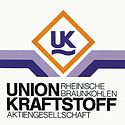Union Rheinische Braunkohlen fuel AG
|
Union Rheinische Braunkohlen fuel AG
|
|
|---|---|
| legal form | Joint stock company , former |
| founding | 1937 |
| Seat | Wesseling , North Rhine-Westphalia |
| Branch | Petroleum company, petroleum refinery, petrochemical |
The Union Rheinische Braunkohlen fuel AG , (also UnionKraftstoff or also just UK ) was a hydrogenation plant founded in 1937 in the course of the self-sufficiency efforts of the National Socialist German Reich , located in Wesseling- Süd. The company's main interest was originally in gasoline production through coal liquefaction . The founding board members of the UK were: Carl Müller von Blumencron, Erich Meissner and Heinz Nedelmann.
Company history
The company was founded as a subsidiary of the Rheinische AG for lignite mining and briquette production (RAG). Initially, the sole purpose of the plant was to produce synthetic gasoline from domestic brown coal using coal liquefaction using the Bergius Pier process , primarily for the army and air force of the Wehrmacht . The lignite required for this was extracted from the nearby Rhenish lignite mining area, mainly from the Berrenrath opencast mine and the United Ville mine . The coal prepared and dried there was brought from Berrenrath to Wesseling on the Villebahn , the Querbahn (HGK) and the Black Railway . The nearby Rhine was used as a transport route for the tankers and the water was used for cooling. Production started in 1941 and in the following year 250,000 tons of fuel were produced.
During the Nazi era, the company employed several thousand forced laborers . The employed slave laborers were housed in wooden barracks, which were located in the so-called south camp . A second barrack camp was located directly on the Rhine, the so-called Rhine camp
After several heavy air raids in July and October 1944, the plant came to a standstill towards the end of 1944.
After the end of the Second World War in 1945, the destroyed refinery was rebuilt. Due to the requirements of the Allied Control Council , it was initially forbidden in Germany to produce fuel. As a result of this emergency, Union-Fuel AG found new production methods and initially used its hydrogenation plants to produce ammonia for the fertilizer industry using the Haber-Bosch process . Later ureas were also processed into fodder .
From 1949, the plant began producing fuels again, but this time on the basis of crude oil . 1956, the UK took part in the North-West oil pipeline ( Pipeline ).
The UK used its own invention for the production of methanol and thus gained a huge market lead. With the in-house Peukert-Hilberath process (Ernst Peukert & Friedrich Hilberath) for methanol production, the UK became the largest methanol producer in Europe in the 1960s.
In the decades that followed, the UK developed into an efficient oil refinery and increased its crude oil capacity from an initial 250,000 tons to several million tons per year. In 1985 the product range was expanded to include jet fuels , and from 1986 lubricants were also manufactured.
In 1989, the processing and sales activities of the UK were incorporated into DEA Mineraloel AG. The remaining activities were transferred to RWE-DEA AG. In connection with all other DEA refineries, the UK-Wesseling plant has now concentrated on the manufacture of high-quality mineral oil products and basic petrochemicals .
In 2002 a joint venture was started with Shell & DEA Oil GmbH Rheinland Raffinerie Werk Wesseling ( RWE Dea ), which resulted in the complete takeover of the refinery operations by Shell Deutschland Oil GmbH - Rheinland Raffinerie , Wesseling plant.
literature
- Hans-Josef Joest: KraftAkte - Half a century of Union fuel in Wesseling. ECON Verlag, 1987, ISBN 3-430-15097-3 .
Individual evidence
- ↑ VDI (ed.): History of technology. Volume 65. Association of German Engineers, 1998, p. 151.
- ↑ Gustav Stolper (ed.): The German economist. Journal for Politics and Economics. Volume 14. Berlin, 1938, p. 1614.
- ↑ http://www.historicum.net/themen/zwangsarbeit-rhein-erft-rur/ausstellung/region/ Rhein-Erft-Rur region and the use of forced labor
- ↑ http://www.historicum.net/themen/zwangsarbeit-rhein-erft-rur/ausstellung/arbeitseinsatz/in-der-industrie/ Forced laborers in industry
- ↑ http://www.historicum.net/themen/zwangsarbeit-rhein-erft-rur/ausstellung/lebensumstaende/barackenlager/ living conditions in barracks
- ↑ Archived copy ( memento of the original from October 29, 2013 in the Internet Archive ) Info: The archive link was inserted automatically and has not yet been checked. Please check the original and archive link according to the instructions and then remove this notice. Photo: Südlager-Wesseling
- ↑ Archived copy ( memento of the original from October 29, 2013 in the Internet Archive ) Info: The archive link was inserted automatically and has not yet been checked. Please check the original and archive link according to the instructions and then remove this notice. Photo: Rheinlager-Wesseling View 1
- ↑ Archived copy ( memento of the original from October 29, 2013 in the Internet Archive ) Info: The archive link was inserted automatically and has not yet been checked. Please check the original and archive link according to the instructions and then remove this notice. Photo: Rheinlager-Wesseling View 2
- ↑ Archived copy ( memento of the original dated July 6, 2007) Info: The archive link was inserted automatically and has not yet been checked. Please check the original and archive link according to the instructions and then remove this notice. 18/19 July 1944 - Attack the synthetic-oil plant at Wesseling
- ↑ http://www.raf.mod.uk/bombercommand/oct44.html October 30, 1944 - Raid on the oil refinery at Wesseling
- ↑ Archived copy ( memento of the original from September 24, 2015 in the Internet Archive ) Info: The archive link was inserted automatically and has not yet been checked. Please check the original and archive link according to the instructions and then remove this notice. - German Patent Office - Peukert-Hilberath patent specification
Web links
Coordinates: 50 ° 49 ′ 7 ″ N , 7 ° 0 ′ 36 ″ E

